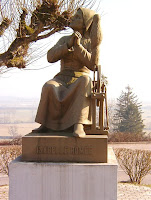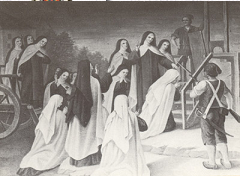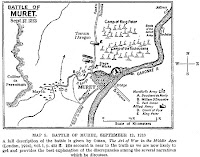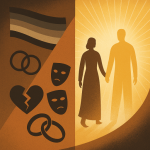 Guest post by William “Mac” McCarthy
Guest post by William “Mac” McCarthy
Blogging makes surprising connections. Back in the day when I was a lapsed Episcopalian and he was the rare Catholic at our New England school, Mac lived down the hall from me. Forty years later, now an attorney in Bakersfield, California, he read YIM Catholic and quickly promised me a write-up on an extraordinary group of Catholic martyrs, whom we honor on July 17.
“Permission to die, Mother?”
“Go, my daughter!”
During the French Revolution’s Reign of terror, on the evening of July 17, 1794, in Paris’s Place de la Nation, a hardened crowd waited at the guillotine for the carts carrying that day’s “batch” from the Palais de Justice. A heavy stench from the putrefying blood in the pit below the scaffold hung over the plaza. During the five weeks the guillotine had stood in the Place de la Nation, a thousand severed heads had fallen into the blood-stiffened leather bag of Sanson, the Paris executioner. The blood pit had been enlarged once already but had quickly filled up again.
Usually, raucous jeers from where Rue du Faubourg St. Antoine emptied into the plaza would signal the approach of the tumbrels carrying the condemned. Not this night. A strange hush spread into the plaza. Then there was something else. Singing. Serene, female voices intoning a cool, effortless chant of verse after verse of the Te Deum.
When the tumbrels rolled up to the scaffold, the crowd grew silent. The singers were sixteen sisters from the Discalced Carmelite monastery in Compiegne. They wore long white choir mantles (cloaks) over brown robes similar to nuns’ habits. Such attire had long since been outlawed in the new order. But these women were not of the new order. Their religious clothing and singing in Latin embodied the lost time before the storming of the Bastille and the start of the revolution on July 14, 1789. Also, while plenty of priests and some nuns had been executed individually, never had an entire religious community been carted up to the guillotine. Their radiant, happy faces were wrong for this place. They should have looked sad. They were about to die. They looked joyous. The other twenty-four condemned prisoners with them looked unhappy.
The reason for the Carmelites’ happiness was their belief that the guillotine was the answer to their prayers. Every day for almost two years, since about the time of the September 1792 massacres, the sisters had made a daily act of consecration in which they offered their own lives to God as a sacrifice to restore peace, help France, and stop the killing. For Christ, their heavenly Spouse, to actually accept their offer of themselves in holocaust and grant them their martyrdom gave them great joy.
Three hours earlier at the Palais de Justice, the sisters had been condemned to death. A show trial proved them “enemies of the people.” The blatantly false charges included “hiding weapons in your convent.” In answer, the 41-year old prioress, Mother Teresa of St. Augustine, lifted her crucifix from her bosom and held it up to the presiding judge saying, “The only weapon we’ve ever had in our convent is this. You cannot prove we have ever had any others.” They had no convent anyway. The revolutionary government had confiscated it and ejected them in September 1792. Carmel Compiegne and everything in it had been sold to finance the revolution.
A fellow prisoner who saw them return from hearing their death sentences reported their faces were “beaming with joy.” A Parisian working class woman who watched the Carmelites pass by on the tumbrels had shouted, “What good souls! Just look at them! Tell me if you don’t think they look just like angels! I tell you, if these women don’t go straight to paradise, then we’ll just have to believe it doesn’t exist!”
At the scaffold, the sisters performed devotions normal for dying Carmelites. The nuns renewed their monastic vows of poverty chastity and obedience. They sang the Veni Creator Spiritus:
Come, Holy Ghost, Creator blest,
and in our hearts take up Thy rest;
come with Thy grace and heav’nly aid,
To fill the hearts which Thou hast made. …
One sister, was heard to cry out, “Only too happy, O my God, if this little sacrifice can calm your wrath and reduce the number of victims.”
Then Mother Teresa of Saint Augustine walked over to the foot of the scaffold steps and turned to face her spiritual daughters. In the palm of her hand, the prioress held a tiny terracotta image of the Virgin and Child, a last relic saved from Carmel Compiegne. She summoned Sister Constance, the youngest sister, who approached.
This was 29-year-old Sister Contance’s first act of obedience as a professed Carmelite. Moments before, as her sisters were renewing their vows, she was pronouncing her vows for the first time. In 1789, at the start of the Revolution, just before she completed her novice year, the revolutionary government prohibited the taking of religious vows. So, after six years as a novice, she finally made her profession in extremis. Previously, she had expressed a terrible fear of the guillotine. She would show no fear this night.
At the steps, Sister Constance knelt at her prioress’s feet and received a blessing. She kissed the clay Madonna and Child cupped in her prioress’ hand. Finally, bowing her head, she asked:
“Permission to die, Mother?”
“Go, my daughter!”
Sister Constance rose from her knees. A witness described her as radiant as “a queen going to her receive her diadem.“ As she began her climb up to the scaffold, she spontaneously intoned the Laudate Dominum omnes gentes, the 117th Psalm. That psalm was sung by the Discalced Carmelite Order’s mother-foundress, St. Teresa of Avila, at the foundation of every new Carmel in 16th-century Spain. Hearing Sister Constance, her sisters immediately took up the chant:
Praise the Lord, all ye nations!
Praise Him all ye people!
For his mercy is confirmed upon us,
And the truth of the Lord endureth forever!
Praise the Lord!
At the top of scaffold steps, still joined in chant with her sisters, Sister Constance waved aside the executioner and his valet. She walked on her own to the vertical balance-plank; was strapped to it; and then lowered into horizontal position. With a swoosh and a thud, the guillotine had cut the number of voices to 15. The remaining voices rose in defiance. Even before her falling head reached Sanson’s leather bag, Sister Constance was in the arms of her heavenly Spouse in the Kingdom of the Lamb.
The exact order in which the other 15 sisters climbed the scaffold has not come down to us. We know only the last two sisters. What is known is that the guillotine mob remained silent the whole time, an almost impossible–or one could say miraculous–occurrence. The bumps, clicks, swooshes and thuds of the death apparatus told of the deadly business. But the calm, austere chant of the Laudate Dominum never stopped.
About every two minutes, one voice would fall away from the others, to be heard no more by mortal ears. Each sister, when her time came, went to her Mother and knelt; received a blessing; and kissed the Madonna and Child statuette.
“Permission to die, Mother?”
“Go, my daughter!”
Here are the names of the other sisters:
Sister Jesus Crucified, choir sister, age 78. She and Sister Charlotte had celebrated their jubilee of 50 years of profession.
Sister Charlotte of the Resurrection, choir sister, age 78. The martyrs arrived at the Paris Concierge (jail) from Compiegne on July 13 after a two-day journey in open carts. Sister Charlotte was unable to rise and step out of the cart with her sisters. She could only walk with a crutch, but her hands were tied behind her back. Exhausted, she sat alone in the tumbrel in the soiled straw. An angry guard jumped up and tossed her out onto the cobblestones. After lying still for a while, Sister Charlotte lifted her bloodied head and gently thanked the brutal guard for not killing her. She wanted to live long enough to make her witness with her sisters.
Sister Euphrasia of the Immaculate Conception, choir sister, age 58
Sister Julie Louise of Jesus, choir sister, age 52. Sister Julie Louise of Jesus entered Carmel as an aristocratic young widow. Well educated and musically talented, she composed a song or poem every year for the community’s July 16 patronal festival, the feast of Our Lady of Mount Carmel. This year, at the Concierge in Paris, since writing materials were forbidden in jail, she managed to obtain scraps of charcoal. She composed a long five stanza song about a happy martyrdom and set it to the tune of the bloodthirsty La Marseillaise. One line went, “Let’s climb, let’s climb, the scaffold high!” The day before they went to the guillotine, all the sisters gaily sang Sister Julie Louise’s feast day song. Their only disappointment was they would not die on the feast of Our Lady of Mount Carmel.
Sister Teresa of the Heart of Mary, choir sister, age 52
Sister Saint Martha, lay sister, age 52
Sister Catherine, extern, age 52
Sister Marie of the Holy Spirit, lay sister, age 51
Sister Teresa of Saint Ignatius, choir sister, age 51
Mother Henriette of Jesus, past prioress and novice mistress, choir sister, age 49
Sister Teresa, extern, age 46
Sister Saint Louis, subprioress, choir sister, age 42
Sister Saint Francis Xavier, lay sister, age 30
Sister Henriette of the Divine Providence, choir sister, age 34. This sister was the second to last to die. She was a fiery beauty, whose nine adult bothers and sisters included two priests and five nuns. Fearing her natural beauty would be a distraction, she had withdrawn from the Sisters of Charity of Nevers, a public nursing order and sought out the hidden life in the cloister at Carmel. One of her sisters became the Superior General of all the Sisters of Charity of Nevers. (This was the order of St Bernadette of Lourdes.)
In the courtroom at the Revolutionary Tribunal on the day of her martyrdom, she boldly challenged the Tribunal’s notorious public prosecutor, Antoine Fouquier-Tinville, to define what he meant by calling her community “fanatic.” In response to her repeated demands that he stop avoiding her question and answer it, the prosecutor finally said their “attachment to their religion” made them criminals and dangers to public freedom. At the guillotine, since she was the Carmel’s infirmarian, she took a place by the steps and helped her older, weaker sisters up the scaffold steps.
The psalm chant stopped only when the last Carmelite, the prioress—Mother Teresa of Saint Augustine, age 41, had climbed the scaffold steps and followed her daughters. She was the only child of an employee of the Paris Observatory. Since she was not from a wealthy family, the generous young Dauphine of France, Marie Antoinette, had paid her dowry for Carmel. The prioress was well educated and artistic. Some of her paintings still hang on the walls of French Carmels. She was only 34 when she was first elected prioress. She is believed to be the first nun to have felt the call to community martyrdom.
Before beginning her walk up the steps, the prioress made the sign of the cross and paused. A pious woman in the crowd, who saw the hesitation, understood and moved up to discreetly take the tiny terracotta Virgin and Child statuette from the hand of the great prioress of Carmel Compiegne. The statuette was kept safe and has come down to us.
Ten days after the Carmelites of Compiegne fulfilled their vow and offered themselves up in sacrifice to stop the bloodshed, Robespierre fell from power. A bloody revolutionary, he was a key architect of the Reign of Terror. The next day, July 28, 1794, he was guillotined and the Reign of Terror soon faded.
That the martyrs were able to wear parts of their forbidden habits at the guillotine, like their white choir mantles, was due to unusual coincidences or, more likely, the hand of God. After their expulsion from Carmel Compiegne, they had been forbidden to wear their habits. With no money to buy clothes, they had to accept worn out, cast-off, immodest clothing. They draped scarves over their shoulders and necks to protect their modesty.
But, on July 12, 1794, in the jail in Compiegne (a confiscated convent) they had donned what remained of their habits in order to wash their single outfits of civilian clothing. At the same time, the mayor received an order from the Paris Committee of Public Safety ordering the martyrs’ immediate transport to Paris for “trial.” The secular clothes were soaking in wash tubs. Delaying the execution of the Paris order was unthinkable (and too risky) for the Compiegne officials. Therefore, the martyrs went to Paris in what they had left of their forbidden habits. Perhaps, when their Lord decided to accept their offer of martyrdom, He also granted the martyrs the tender mercy of dying in their beloved, long, white choir mantles.
The worn-out, immodest civilian clothes left soaking in the tubs at Compiegne had yet another role in God’s plan. Confined in the Compiegne jail with the Carmelites had been 17 English Benedictine sisters. Four others had already died in jail. They had been arrested as foreigners in 1792 at their monastery in Cambrai. A granddaughter of St. Thomas More had founded the monastery when Catholic religious orders were forbidden in England. Though kept apart, Benedictines learned of the Carmelites’ daily consecration to sacrifice themselves to restore peace and free prisoners.
After the Carmelites were taken to Paris, the Compiegne jailers made the Benedictines wear the Carmelites’ abandoned civilian clothes. The Benedictines were still wearing them when they were finally allowed to sail for England in 1795. That community eventually founded England’s famous Stanbrook Abbey. Today, Benedictines at Stanbrook still honor the Carmelites as martyrs whose deaths somehow stopped the killing and saved the jailed Benedictine sisters from the guillotine. In 1895, Stanbrook Abbey returned many of the “wash tub” clothes as venerated relics to the newly reestablished Carmel Compiegne.
The martyrs were beatified by St. Pius X on May 13, 1906. Their memory is celebrated on July 17 by both branches of the Carmelites and the archdiocese of Paris.
Several successful literary and artistic works have helped spread the martyrs’ story around the world. They include Gertrude von De Fort’s famous 1931 novella, Song at the Scaffold, which in turn inspired Georges Bernanos’ Les Dialogues des Carmelites (1949), as well as Francis Poulenc’s opera (1957) and an Italian-French film (1959), both also named Les Dialogues des Carmelites.
Almost all the historical facts used in this post come from William Bush’s outstanding book, To Quell the Terror: The Mystery of the Vocation of the Sixteen Carmelites of Compiegne Guillotined July 17, 1794, ICS Publications (1999). The same goes for a lot of the wording and observations in this posting. Bush has spent many years studying the martyrs. His book has a picture of the terracotta statuette and photos of art work by the martyrs, including a beautiful pastel of Christ on the Cross by Mother Teresa of Saint Augustine. Any errors, misstatements, or unclear writing here in this post are this writer’s fault.
For a short, brilliant essay on the martyrs, Catholicism, and modern times, read “The Mantle of Elijah: The Martyrs of Compiegne as Prophets of the Modern Age” by Terrye Newkirk, OCDS. It is only 11 pages and easily downloaded from the ICS website.
“Permission to die, Mother?”
“Go, my daughter!”
 Like me, Webster is partial to Gerard Manley Hopkins, a 19th century poet who also was a Catholic convert and a Jesuit. (Depicted here bronze by Irish sculptor Rowan Gillsepie). Webster has cited Hopkins’s poems here, here and here.
Like me, Webster is partial to Gerard Manley Hopkins, a 19th century poet who also was a Catholic convert and a Jesuit. (Depicted here bronze by Irish sculptor Rowan Gillsepie). Webster has cited Hopkins’s poems here, here and here.


























